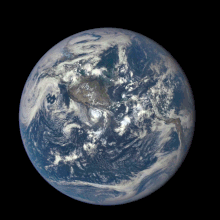Deep Space Climate Observatory
| DSCOVR | |
|---|---|

|
|
| Type: | Earth observation satellite |
| Country: |
|
| Operator: |
|
| COSPAR-ID : | 2015-007A |
| Mission dates | |
| Begin: | February 11, 2015, 23:03:32 UTC |
| Starting place: | Cape Canaveral SLC-40 |
| Launcher: | Falcon 9 |
| Status: | Operation interrupted |
| Orbit data | |
| Track height: | Lissajous orbit around the earth-sun L 1 point |
The Deep Space Climate Observatory (German: Climate observatory in deep space), abbreviated DSCOVR , formerly Triana , is a satellite for observing certain aspects of the solar and earth climates and an advance warning system for geomagnetic storms . The total projected cost of the mission of $ 340 million will be borne by NASA , NOAA, and the US Air Force .
purpose
Magnetic storm warning system
DSCOVR determined with a plasma - magnetometers the strength and direction of the solar wind with a very high temporal resolution. His measurements should also serve to warn of geomagnetic storms , which can cause serious problems with satellites, power grids , GPS and communication systems on Earth . Since the charged particles from the sun move more slowly than the radio signals from the satellite, DSCOVR, which the solar winds reach in front of the earth, can warn the earth in advance. In this role, he will act as the successor to NASA's Advanced Composition Explorer satellite, which was 17 years old in 2015 .
NOAA and the US Air Force want to achieve a warning time of 15 to 60 minutes in the event of geomagnetic storms . NOAA operates the satellite from its NOAA Satellite Operations Facility in Suitland , Maryland and forwards data from there to its partners. She processes the data herself in her NOAA Space Weather Prediction Center in Boulder , Colorado and then archives the data in the NOAA National Geophysical Data Center , also in Boulder, Colorado.
Earth observation
With the help of the Enhanced Polychromatic Imaging Camera (EPIC), the satellite records the entire illuminated hemisphere in ten different spectral ranges. The multicolor camera covers the near ultraviolet at 317 nanometers and the visible light up to 779 nanometers (red).
With the radiometer Nistar (National Institute of Standards & Technology Advanced Radiometer), the satellite measures the flow of light reflected from the Earth's surface solar radiation, on three different channels with different spectral ranges from infrared to visible light through to the ultraviolet range:
- Wavelength range from 0.2 to 100 micrometers ;
- Wavelength range from 0.2 to 4 micrometers;
- Wavelength range from 0.7 to 4 micrometers;
Another channel (0.3–1 µm) is used for calibration .
prehistory

DSCOVR was proposed as an Earth observation satellite in 1998 by then US Vice President Al Gore .
The original purpose of the satellite was to provide an almost uninterrupted view of the entire globe and to make these images available live on the Internet. Gore not only tried to promote science with these images, but also to raise awareness for the earth itself and its protection. He hoped that the influence of the iconic Blue Marble photos, the first of which was taken by Apollo 17 , on the planet's environmental movement could be replicated with the new images from DSCOVR.
In addition to the imaging camera, a radiometer should take the first direct measurements of the amount of sunlight reflected from the earth (see albedo ). This data could be used to calculate global warming . Scientific goals range from measuring the amount of solar energy reaching the earth, through cloud patterns, weather systems, and vegetation monitoring, to measuring the amount of ultraviolet radiation that penetrates the ozone layer to the surface of the earth.
Mocked by critics as a haphazard project, the satellite was nicknamed GoreSat . It was often referred to as an "overpriced screen saver" by representatives of the Republican Party . The Congress made a request to the National Academy of Sciences whether the project would ever rewarding. The results from this inquiry report described the project as "strong and vital" ( strong and vital ).
DSCOVR was initially called Triana and was named after Rodrigo de Triana , the crew member on Columbus' ship Pinta , which was the first to discover American land. However, in order to gain new support for their project, NASA renamed the project Deep Space Climate Observatory .
Faced with politically motivated opposition and support from science, the DSCOVR project could neither be carried out nor discontinued. The satellite was not launched as originally planned as part of the STS-107 mission (the Columbia disaster). Rather, the $ 100 million satellite was in storage for a million dollars a year.
In December 2012, SpaceX announced that the 2014 DSCOVR satellite would be launched with SpaceX's Falcon-9 rocket; the start was postponed several times.
position
The Lagrange point L 1 between the earth and the sun, at a distance of 1.5 million kilometers from the earth, was selected as the position for DSCOVR , where the gravitational force of the earth cancels that of the sun just to the extent that the satellite is at this point circles the sun synchronously with the earth. DSCOVR is on a Lissajous orbit around the Lagrange point L 1 with a period of six months, whereby the earth, sun and DSCOVR are at an angle between 4 and 15 degrees.
Mission history
DSCOVR was launched on February 12, 2015 at 00:03 a.m. CET from Cape Canaveral in Florida with a Falcon 9 launcher from SpaceX . SpaceX successfully brought DSCOVR into space, but could not land the first stage of the Falcon-9 on a platform in the sea, the Autonomous spaceport drone ship , as planned, as this could not be used due to the high waves.
110 days after launch, the satellite should have reached its intended position in space between the earth and the sun; since summer 2015 he has been performing his regular duties.
In June 2019, the satellite was temporarily put into "Safehold" mode, thus interrupting scientific operations in order to resolve a problem in the situation control system. At the beginning of March 2020, NOAA announced that DSCOVR was fully operational again.
See also
Web links
- Deep Space Climate Observatory - NOAA
- Project page of the Scripps Institution of Oceanography at the Atmospheric Research Laboratory. ( Memento from June 30, 2007 in the Internet Archive ) University of California, San Diego (English)
- Triana website ( memento of August 25, 2009 in the Internet Archive ) - NASA (English)
- Review of Scientific Aspects of the NASA Triana Mission . National Research Council Report, March 3, 2000
- Politics puts $ 100 million satellite on ice . The Orlando Sentinel, July 15, 2001
- SpaceX launches DSCOVR . Raumfahrer.net, February 12, 2015
Individual evidence
- ↑ a b c d NASA Earth Science Instruments. In: DSCOVR: Deep Space Climate Observatory. NOAA / Satellite and Information Service, October 21, 2014, accessed December 21, 2016 .
- ↑ National Institute of Standards & Technology Advanced Radiometer (NISTAR). (PDF) NOAA Satellite and Information Service / Deep Space Climate Observatory (DSCOVR), accessed August 11, 2015 .
- ^ NASA's Triana Mission Scientific Evaluation Completed . ( Memento from August 2, 2007 in the Internet Archive ) NASA (English)
- ^ SpaceX Awarded Two EELV-Class Missions from The United States Air Force. SpaceX, December 5, 2012, accessed December 8, 2012 .
- ^ Tilmann Althaus: Sun research. New satellite launched for solar observation. Spektrum.de, February 12, 2015; accessed on February 16, 2015
- ↑ DSCOVR spacecraft in safe mode. Spacenews, July 5, 2019, accessed on September 2, 2019 .
- ^ NOAA's DSCOVR Satellite is Operating Again . National Oceanic and Atmospheric Administration, March 2, 2020.

